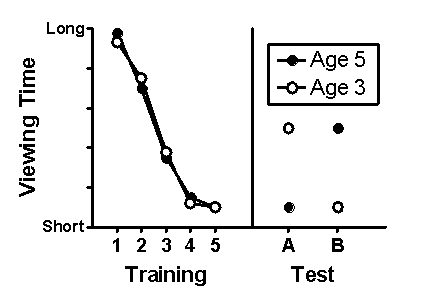Scenario I
Scenario I is based on and presents fabricated results consistent with the following study:
Kim, I. K., & Spelke, E. S. (1992) . Infants' sensitivity to effects of gravity on visual object motion. Journal of Experimental Psychology: Human Perception and Performance, 18(2) , 385-393.
Kim and Spelke (1992) investigated the extent to which infants have expectancies of gravitational effects on visual object motion. Three- and five-month-old infants repeatedly watched a video of a ball accelerating as it rolled down an incline until they spent little time actively looking at it. Subsequently, two types of test trials were conducted in randomized order. Type A test trials consisted of a ball slowing down as it rolled up an incline. Type B test trials consisted of a ball slowing down as it rolled down an incline. During all trials, the amount of time looking at each visual display was recorded. Fabricated data consistent with the major finding of this study are presented in Figure 11.1.
Figure 11.1 
-(Scenario I) Which is a true inference based on the data shown in Figure 11.1?
Definitions:
Distance Cues
Visual or auditory information that helps an organism perceive the distance to an object or sound source.
Horizon Moon
Reflects the visual phenomenon when the moon appears larger near the horizon than it does higher up in the sky.
Depth Cue
Visual information that allows a person to judge the distance and 3D characteristics of an object, including factors such as lighting, perspective, and overlap.
Tall, Thin Glass
A container made of glass with a taller height compared to its diameter, often used for serving beverages.
Q1: Sophia competes successfully at national-level spelling bees.
Q4: Throughout adolescence, people spend _ time with
Q9: Describe how people might unconsciously employ the
Q10: Describe Piaget's and Kohlberg's stages of moral
Q27: George Kelly believed that differences in personality
Q67: According to the textbook:<br>A)an "intelligence gene" directly
Q69: Infants learn to control their hands and
Q74: The overwhelming majority of American mothers report
Q78: Economic and social variables appear to account
Q87: Experiencing starvation during pregnancy is associated with